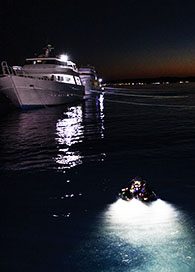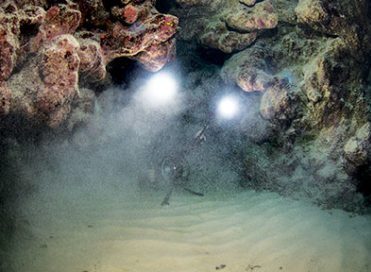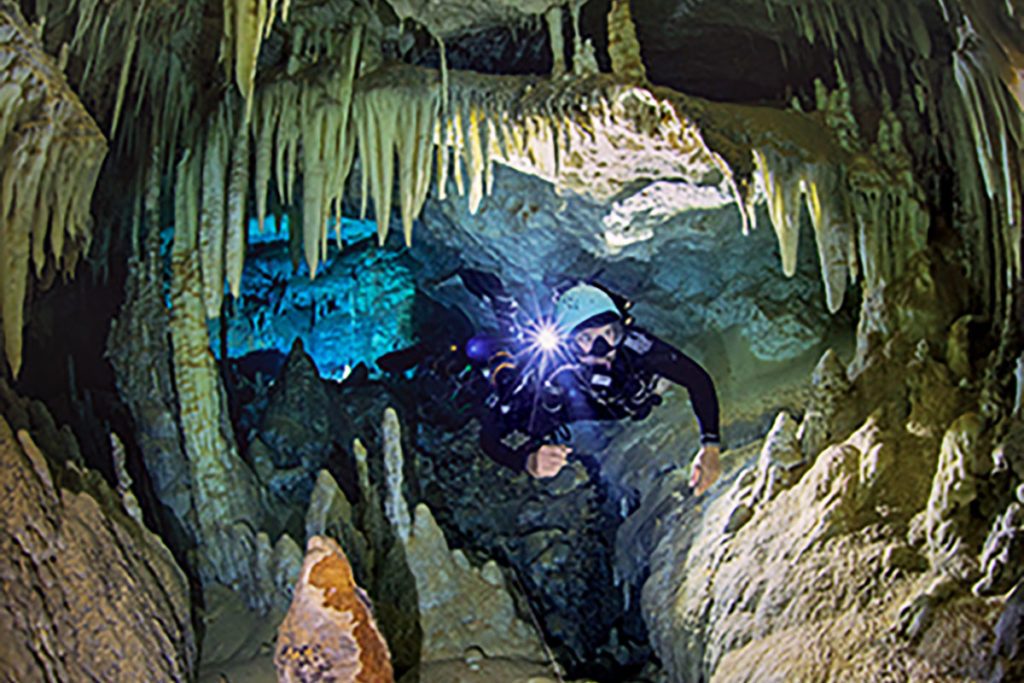WEATHER, SILTY SEDIMENT, time of day, or water movement are just a few natural factors among the range of possible causes that can influence the visibility at your dive site. Low-visibility diving can be quite enjoyable, but it depends on the circumstances and your comfort level.

Photo by Stephen Frink

Photo by Stephen Frink
Why do people dive in low-visibility environments?
Some divers, such as public safety divers, might have to venture into low-visibility situations. Recreational divers may have no clear water nearby but want to dive regardless. Searching for great treasures, such as blackwater diving for megalodon teeth, is adventurous, even for experienced divers. Some creatures only come out for the critter hunters to see when it is dark or when the sea is a bit more disturbed than is comfortable.
Most of these scenarios are predictable, but low visibility becomes especially tricky when a diver is unprepared. Touching down on a muddy bottom upon entry or one wrong fin stroke or hand movement in a silty, easily disturbed environment can put an end to what visibility you have.
What is the worst thing that could happen?
It can be a fun experience to dive without seeing anything. When you need to rely totally on your ears and hands, you will be surprised by how quickly your body can adjust to the new situation.
A complete loss of orientation, however, can be alarming. If you have little or no experience in poor visibility but must suddenly deal with it, it would not be surprising for panic to set in. Panic is among a diver’s worst enemies and can ultimately lead to death in a rare worst case, but it is something you can overcome through preparation and training.
The most important thing to remember is that if you see that you cannot control the dive conditions and don’t know if you are up for the challenge, call the dive. You can do so before or at any time during the dive.

Photo by Jill Heinerth
How can we deal with bad visibility?
Tools: If you know that visibility will be poor when planning a dive, make sure you have the right gear with you and the confidence to use it. This equipment may include underwater lights, a strobe light, a surface marker buoy (SMB), spools, a reel, and a compass.
Lights can help in low visibility, but they can also make it worse in some conditions. If particles and disturbed sediment are abundant in the water, a light will illuminate those particles, which can be bright and make it harder to see where you are going. You might need to angle your light downward rather than straight in front of you and reduce the light intensity. A strobe light is a good option for marking an entry or exit point in low visibility. It might also be a way to mark yourself by illuminating your tank so your buddy can more easily spot you if you get separated.
After a separation incident, buddies are less likely to find a diver dressed in a black suit, hood, mask, gloves, and fins. Bright colors are a safety asset in low visibility. If you lose visual contact with your dive partner, follow your agency’s recommendations. These procedures usually include carefully searching — in this case with all your available senses — for one minute before surfacing to reunite the team. While you search, remember that you are in a 3D environment and cover all directions.
A spool or reel can be useful for safely finding your way back to where you came from if you know how to deploy it and reel it in without making a mess. Cavern or wreck diving classes will teach you how to use a reel or finger spool. You do not have to start cave diving to benefit from the skills an entry-level overhead-environment class can give you.
When you expect limited visibility, go over some additional communication signals with your buddy. Signals using light or touch may be the only way to communicate.
Lines: Public safety dive teams combat low or no visibility with a tended line, but that is not a valid option for a sport diver without the necessary training. Using lines, however, is a strategy that all divers can employ. A buddy line is an option for two teammates who do not want to get separated. Buddy lines are relatively short ropes — short enough to limit entanglement but not too short to prevent movement — connected to your gear with carabiners or preferably by slipping a loop around your wrist.
Disorientation: If you get disoriented — whether it’s being unable to remember the way back to the boat’s downline or trying to use your bubbles to orient yourself to the surface in a silt-out — you should be able to rely on your predive preparation. Research everything about the dive site before getting in the water. Learn where there are points you can reference during your dive; if you are wreck diving, for example, memorize how deep the wreck lies and at what depth the anchor line is attached. Know that you are on the way back when the wall is on your left shoulder and not your right, remember which direction you went from the entry, or use a compass to navigate back.
If you become disoriented during an open-water dive and can’t safely determine which direction is home, make sure you have the means to signal your location to the surface crew. Separation, signaling, and retrieval procedures should be part of every safety briefing. You should be able to safely deploy an SMB for an unplanned ascent. If current is present and you have the opportunity and know how to, you might want to attach the SMB to the wreck or dive site and follow that line up to ensure you do not drift farther away.
Whatever happens, make a safe ascent, and do not violate your ascent or decompression obligations. You can deal with most problems at the surface. In a true emergency that requires a rapid ascent, do it as safely as possible. Don’t ever worry about ditching nonvital equipment if you have to — losing a spool, a double ender, or weights is much less of a problem than being lost at sea.
Mental preparation: The most important tool you have in your kit is your brain. Do your homework ahead of time, and mentally go through the dive before getting into the low-visibility situation. Review the safety procedures in detail with your teammates, and make sure everyone knows how to react. If your vision gets restricted, take a couple of sanity breaths, and start thinking about your options and strategy. Knowing that you can safely make it out of a challenging situation will calm you, help prevent panic, and potentially lessen your risk of injuries that could occur with an uncontrolled ascent.
Your comfort zone is entirely about you. Are you comfortable in zero visibility? Will you ever be? What is it about this experience that some people love and want to do again and again? If you have not already dived in low visibility, it’s worth trying at least once with someone who has experience. It’s almost meditative for some divers. If you are still not convinced after trying it, nothing is lost. It will make you appreciate crystal-clear waters even more.
You can prepare for many of these situations by taking specialty courses. You can acquire some skills during the course, while the rest will come with practice and exposure. A limited-visibility or night diving course, a cavern class, or an advanced wreck diving course will prepare you for some scenarios you might not have considered. The skills you learn will work for you in murky water and make you a better overall diver.